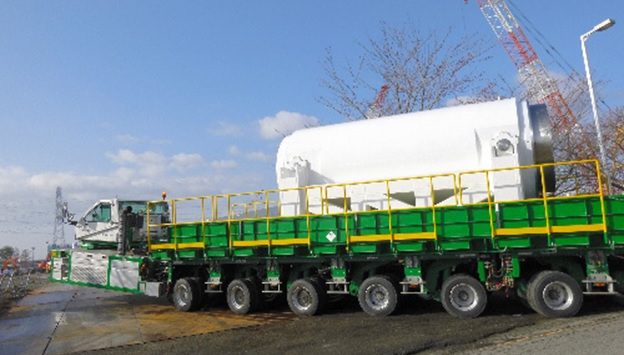Kazuhisa Ogawa
July 21, 2017
I. INTRODUCTION
In this essay, Kazuhisa Ogawa argues for a systematic approach to reduce the risk of global terrorism, including deterrence by denial, and painstaking measures to reduce the risk of nuclear terrorism. He points out that Japan’s official approach remains too formalistic and stove-piped and must be improved by steadfast and painstaking efforts by every sector of Japanese society. He also suggests that a preventative approach is inherently global and should include measures to address the origins and drivers of global terrorism.
Kazuhisa Ogawa is Project Professor, University of Shizuoka
This Special Report was prepared for the Project on Reducing Risk of Nuclear Terrorism and Spent Fuel Vulnerability In East Asia. It was presented at a Nautilus Institute Workshop at International House, Tokyo, September 14-15, 2015, funded by The Macarthur Foundation.
The views expressed in this report do not necessarily reflect the official policy or position of the Nautilus Institute. Readers should note that Nautilus seeks a diversity of views and opinions on significant topics in order to identify common ground.
Acknowledgements: For translation assistance, thanks to Professor Takayuki Nishi, Global Center for Asian and Regional Research, University of Shizuoka
Banner Image Credit: Transportation of a Dry Storage Cask from the Common Pool Building to the Temporary Dry Cask Storage Facility in Fukushima Daiichi Nuclear Power Station, April 4, 2013, from TEPCO Photo Library
II. SPECIAL REPORT BY KAZUHISA OGAWA
VULNERABILITY TO TERRORISM IN NUCLEAR SPENT FUEL MANAGEMENT: AN UNSPARING LOOK AT JAPAN’S CURRENT SITUATION
July 21, 2017
I would like to respond to the organizers’ questions to me regarding this workshop’s theme, “Vulnerability to Terrorism in Nuclear Spent Fuel Management.”
I have been asked to discuss “mega-terrorism risk to Japan in a globalized world,” specifically three questions:
- What factors determine Japan’s vulnerability to non-state actor attack by weapons of mass destruction, especially nuclear WMD, from external and domestic origins?
- What is the current status of Japan’s vulnerability to non-state actor attack by WMD?
- What is the trend of Japan’s vulnerability to non-state actor attack by WMD?
The answer to the first question is obvious to practitioners. Japan’s greatest, deadly vulnerability is its disposition for “NATO.” This “NATO” is not the North Atlantic Treaty Organization, but the disposition of the Japanese state and the Japanese people for “No Action, Talk Only” and against getting things done. I cannot but fear that this disposition will be determinative in enabling a non-state actor attack on Japan by weapons of mass destruction.
Many systems in Japan are likely to fail in a crisis because of formalism; they are only going through the motions. Formalism and stove-piping are especially pronounced in foreign policy, national security, and crisis management, even though the outcome of these policies is all-or-nothing in the sense that the policies fail unless they are the best humanly possible.
Let me take a few minutes to discuss examples of Japan’s disposition for “NATO.”
An illustrative case of crisis management in Japan is the drone incident at the Prime Minister’s Official Residence (Kantei) revealed on April 22 this year. If we examine how the Japanese government responded, we can see that it’s a hundred years too early to discuss how Japan is going to respond to attack by WMD, especially nuclear attack.
The incident was revealed in the morning of April 22, when a Kantei staff found a crashed drone on the roof. A brown plastic bottle (diameter 3 cm, height 10 cm) was attached atop the drone’s airframe and contained a liquid. The word “RADIOACTIVE” and a hazard symbol for radioactivity were written on a sticker on the bottle. The liquid appears to be water contaminated in the Fukushima Daiichi Nuclear Power Plant, and contained Caesium-134 and Caesium-137. Two days later, a male resident of Fukui Prefecture turned himself in and was arrested.
Facility security experts around the world were surprised that the Kantei’s roof was not patrolled for more than a month, and the drone crash was not discovered for thirteen days.
In fact, I warned the Japanese government of Kantei’s vulnerability to airborne attack on March 26, 2002, just before the current building opened. On that day, I inspected the building for security holes, identified dozens of them, and warned the government to fix them at once.
That afternoon, I discussed measures against airborne terrorism with the officials in charge at the National Police Agency; the Defense Agency (now the Ministry of Defense); and the Ministry of Land, Infrastructure, Transport and Tourism with the 9/11 attacks of the previous year fresh in our minds. For Kantei’s roof, I recommended stationing lookouts and setting up cameras; a small air search radar; and acoustic, vibration, and thermal sensors. But the drone incident this year showed that none of them had been implemented.
The career government officials who inspected Kantei for security holes are now administrative vice ministers. Following this year’s drone incident, they recalled, “You recommended measures against special operations forces and terrorists landing on Kantei’s roof by HALO (High Altitude-Low Opening) and hang gliders, and against approach of unmanned aerial vehicles,” and were shocked that none had been implemented.

Drone that crashed atop the Japanese Prime Minister’s Official Residence
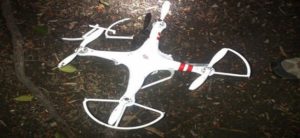 Drone that crashed on White House grounds (USSS photo)
Drone that crashed on White House grounds (USSS photo)
It hardly needs saying that Japanese security officials had not learned from the drone crash on White House grounds on January 26.

Drone crash atop the Prime Minister’s Official Residence
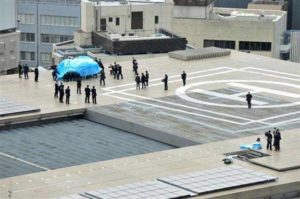
Also, as you can see from the overhead images, Japanese police officers approached the crashed drone without protecting themselves. Even if they did not expect radioactive material (water contaminated in a nuclear power plant) to be found on board the drone, they should have been alert to the possibility that explosives or chemical or biological agents were on board, and worn bomb suits or chemical personal protective equipment when approaching the crash site. The police were not aware that they were endangering their own lives.
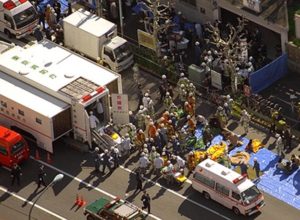
Tokyo subway sarin attack (March 20, 1995)
The state of Japan’s preparedness against chemical, biological, radiological, and nuclear attack twenty years after the Tokyo subway sarin attack also illustrates that the Japanese people have been kept in grave danger.
Since immediately after the Tokyo subway sarin attack on March 20, 1995, I have advocated a national stockpile of antidotes and training of all citizens in their use. In 2000, I supervised the translation (by Takayuki Nishi here) of the First Responder Chem-Bio Handbook used by American first responders, and published the Japanese edition (Seibutsu Kagaku Heiki, published by Keiseisha).
Given a large national stockpile of antidotes and regular training of citizens in their use, terrorists would not be able to expect mass casualties. We can expect terrorists to be deterred from attacking regions where citizens are trained. The United States’ Strategic National Stockpile consists of 1,450,000 doses stored in 2,000 containers at 1,300 sites. I recommended the Japanese government to make an effort based on a similar concept.
In July 2014, however, the Health Science Council was still recommending the Ministry of Health, Labour and Welfare to stockpile antidotes, which means the ministry has no stockpile yet. The government has sat on its hands for twenty years and left the people in danger.
Import to Japan of antidotes to sarin is restricted by the Pharmaceutical Affairs Act, and only Japan Ground Self-Defense Force and the Tokyo Fire Department have been exempted to build a small stockpile.
Another grave problem is that auto-injectors of antidotes like the Mark 1 Nerve Agent Antidote Kit have not been introduced due to lack of coordination of turfs of Japanese government agencies.
Nerve gas attack victims need injections of antidotes as soon as possible. If first responders do not have auto-injectors, then all they can do is extract victims from hot zones, no matter how good the personal protective equipment the first responders are wearing. Solution of this problem needs political leadership to get the Ministry of Health, Labour and Welfare, the Fire and Disaster Management Agency, the National Police Agency, and the Ministry of Defense to cooperate, but an effort based on such awareness is missing.
This workshop’s theme is “Vulnerability to Terrorism in Nuclear Spent Fuel Management.” But a country like this possessing forty-four nuclear power reactors (one in operation, twenty-four applying for restart) without taking all necessary measures to control the release of nuclear energy is in itself a terrifying reality and a giant risk to the whole world.
Before discussing severe accidents of nuclear power plants, let me discuss the actual state of the plants’ preparedness against terrorist attack, which may result in a grave crisis.
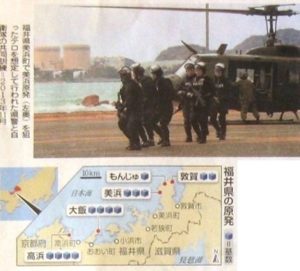
Counter-terror exercise, Mihama NPP, Kansai Electric Power Co., November 2013
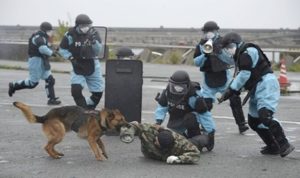
Counter-terror training in a nuclear power plant
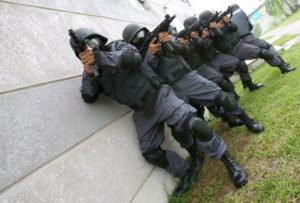
Police Anti-Firearms Squad guarding a nuclear power plant
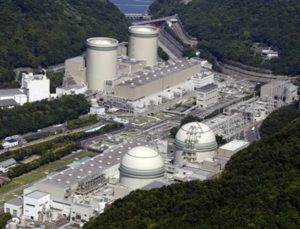
Takahama NPP, Kansai Electric Power Co., Fukui Prefecture
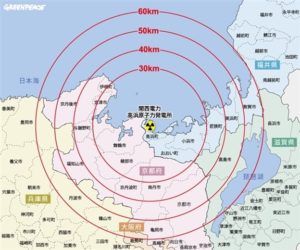
Location of Takahama NPP: 60 km from Kyoto CBD
The residential evacuation training exercise held by Kansai Electric Power Company’s Mihama Nuclear Power Plant in November 2005 illustrates the crudeness and formalism of Japanese nuclear power plants’ counterterrorist measures.
Two months before the exercise, I pointed out the unreality of its scenario to the Cabinet Secretariat. Neither the terrorists’ identity nor their goal was specified. In the scenario, the terrorists were to attack the plant with mortars, defeat the police in a gun battle, and then occupy the main control room, which would perplex any security expert.
If the terrorists’ goal were a widespread power outage, then an attack on transmission facilities in major cities would be far more effective. If their goal were a severe accident, then they would first consider a cyberattack to cause a station blackout. There is no need for a frontal attack on a nuclear power plant.
Japanese specialists, however, assume that nuclear power plants’ cybersecurity takes place only in cyberspace, instead of taking terrorists’ perspective. Thus, Japanese specialists do not understand that causing a station blackout is safe (for terrorists) and easy, once terrorists have obtained the system administrator’s password through a physical vulnerability or social engineering.
As a kind of a bonus, after the exercise in Mihama Nuclear Power Plant, United States Embassy staff’s observation that police were dozing off inside a squad car on the plant’s grounds was disseminated worldwide by Wikileaks.
Electric power companies have not been serious about crisis management of nuclear power plants either.
Two months after the Chūetsu Offshore Earthquake of July 2007, I met a team of Tokyo Electric Power Company’s (TEPCO’s) senior vice presidents twice to provide consultation about the Kashiwazaki-Kariwa Nuclear Power Plant’s emergency shutdown and fire during the earthquake.
At the time, I proposed organizational changes and personnel assignments needed to manage nuclear power, and presented information about remotely operated robots and unmanned aerial vehicles that are the minimum necessary in a severe accident.
But immediately after the Great East Japan earthquake struck on March 11, 2011 and Fukushima Daiichi Nuclear Power Plant’s accident began, a TEPCO executive told me, “Unfortunately, what Ogawa-sensei predicted has happened.” TEPCO had not implemented any of my recommendations to remove obstacles to accident response.
The Great East Japan earthquake also revealed the Japanese government and mass media’s lack of awareness about how other countries responds to nuclear accidents.
For instance, when the deployment of the U.S. Marine Corps Chemical Biological Incident Response Force (CBIRF) to Japan was announced, CBIRF was reported by the press to be capable of controlling nuclear reactor accidents. Japanese reporters did not understand that CBIRF was a more technically capable version of Japan Ground Self-Defense Force’s decontamination units.
Thus, it is no surprise that there is no Japanese equivalent of the U.S. Department of Energy’s Nuclear Emergency Support Team (NEST) or its parent organization, the National Nuclear Security Administration (NNSA), even though NEST appears in Hollywood movies.
As an operational arm of NNSA, the Nuclear Emergency Support Team responds rapidly to nuclear and radiological emergency, and detects and disables any improvised nuclear device or radiological dispersal device. NEST’s team includes nuclear scientists, engineers, medical personnel, meteorologists, legal specialists, and armed personnel. NEST’s equipment includes foam for immobilizing terrorists and containing non-nuclear explosions, four helicopters, three fixed wing aircraft, and special vehicles.
Japan has no equivalent of the U.S. Department of Health and Human Services’ Centers for Disease Control and Prevention (CDC) either.
In contrast to CDC, which is the world’s leading institution for the control and prevention of infectious disease, Japan’s capacity for treating highly virulent and contagious diseases is limited to three Special Infectious Disease Hospitals with eight beds between them, and forty-six Class 1 Infectious Disease Hospitals with eighty-seven beds between them.
Obviously, Japan urgently needs to build a capability similar to CDC, starting with infectious diseases like Ebola virus disease.
Thus, although Japan appears to have certain measures in place against attack by weapons of mass destruction, they are just for going through the motions, and too stove-piped to work in practice.
Regarding the organizers’ second question for me, the current status of Japan’s vulnerability to non-state actor attack by WMD, it is clear from my discussion so far that biological and chemical terrorist attacks can kill large numbers of people in Japan. Therefore, I have no choice but to say that the threat always exists.
Japan is in a critical situation with respect to nuclear and radiological terrorism too, especially from storage and transport of nuclear fuel, spent nuclear fuel, and nuclear waste.
Spent nuclear fuel from Japanese power plants has been reprocessed in Britain and France. Currently, Japan is storing 10.8 tons of separated plutonium in Japan, 20.7 tons in Britain, 16.3 tons in France, for a total of 47.8 tons.
In 1992, plutonium was shipped from France to Japan in a cargo ship escorted by Japan Coast Guard’s Large Patrol Vessel, which was built for this mission, and guarded by Japan Coast Guard’s Special Security Team. From 1999 to 2010, United Kingdom-flag armed merchantmen guarded by UK Atomic Energy Authority Constabulary (which became the Civil Nuclear Constabulary in 2005) aboard shipped plutonium from Britain and France to Japan.
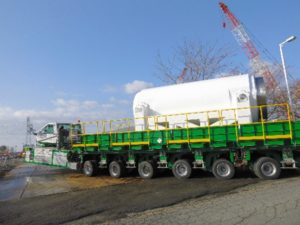
Transport of spent nuclear fuel
More neglected is security of transport of hazardous materials that are inputs or outputs of nuclear facilities, even though terrorists may exploit this vulnerability for radiological attack, also known as the “dirty bomb.”

Transport of uranium hexafluoride
For instance, tanker trucks transported hydrogen fluoride on the expressway through the Ginza area of Tokyo without telling police in advance, therefore without arranging police escort, until I pointed this out to officials. A whistleblower warned me that if the tank on the truck were hit by sniper fire on a rainy day, gasified hydrogen fluoride will leak and contaminate the area along the truck’s route.
Those in charge of the shipment’s security and a specialist on nuclear power, however, dismissed this concern on the grounds that “even if the truck were transporting uranium hexafluoride, it cannot be ignited with a bullet that had cooled in flight, because the boiling point is 56.5 degrees Celsius.” They did not know about the kind of rifle ammunition called incendiary rounds, which are for igniting targets.
We must expect that terrorists can cause panic in Japanese society by dispersing radioactive material much more easily by means other than shooting these tanker trucks. In the residential evacuation training exercise at the Mihama Nuclear Power Plant, a realistic scenario would have included attacks on pipes outside the reactor and peripheral facilities to release a small amount of radioactivity.
Core melt accident approaching a nuclear attack in danger is possible through cyberattack by a group of proficient hackers. When I provided consultation to an electric power company about the security of its central computing center, an American cybersecurity expert (a former hacker) took over the systems for controlling power generation and transmission in forty seconds.
But I have a question about the current status of Japan’s vulnerability to non-state actor attack by weapons of mass destruction. Would terrorists take the risk of attacking storage and transport of spent or reprocessed nuclear fuel?
If terrorists seized a ship carrying MOX fuel, could they improvise a nuclear explosive device aboard, and either detonate the device near a port of a major country (including Japan) or threaten detonation?
Assuming nuclear terrorists would prefer to steal MOX fuel to unprocessed spent fuel, is it difficult to separate plutonium from MOX fuel and refine and machine it?
Burning low-enriched uranium fuel in a light water reactor to generate maximum electricity transforms 1.2 percent of the fuel into plutonium. Each metric ton of this spent fuel contains one and a half IND’s worth of plutonium. The rest of the spent fuel is 93.4 percent uranium; 5.2 percent fission products, most of them strongly radioactive; and 0.2 percent minor actinides, which are radioactive.
The United States and other nuclear weapon states support export of light water reactors to non-nuclear weapon states because the technology to reprocess this spent fuel and separate plutonium is difficult. No country has made a nuclear weapon with plutonium made in a light water reactor. The United States tolerates reprocessing by Japan, because Japan cannot separate plutonium metal for nuclear explosives as long as plutonium is handled only as solutions or MOX and monitored by IAEA.
Separating plutonium metal from MOX fuel is easier than from unprocessed spent fuel, because MOX fuel contains 4 to 10 percent plutonium, the rest being weakly radioactive uranium. Therefore, the United States does not support the use of MOX fuel by non-nuclear weapon states other than Japan.
We must assume nuclear terrorists do not fear exposure to radiation as long as it does not interfere with their mission. They will not seek to limit exposure more than is necessary to live long enough to build and use the nuclear explosive device.
Even if terrorists can build it, the ship can be sunk before the terrorists finish building the IND. But if the terrorists were threatening “hostages” with biological and chemical attacks, perhaps states’ options for responding to the terrorists aboard the ship might be limited?
The organizers’ third question, the trend of Japan’s vulnerability to non-state actor attack by WMD, is a question I would like to ask American participants.
First, we need to understand why non-state actors would attack Japan. What do Islamist extremists seek? Al-Qaeda seeks to reconstruct the Muslim world of the seventh to the thirteenth century in which Sharia was the only law. IS (the so-called Islamic State) interprets Sharia as violently as possible and seeks to usher in the end time prophesied in the Koran. A country which represents modern civilization like Japan is a natural target. Islamist extremists have not perpetrated a terrorist attack in Japan yet because they have been attacking other countries first; this is a matter of luck.
Moreover, IS is utterly different from earlier Islamist radical groups like al-Qaeda in not limiting recruitment to those who are already Muslim or have lived in majority-Muslim countries. IS makes full use of the Internet to recruit combatants in various languages, including those who hardly know anything about Islam.
IS welcomes everyone who feels alienated from their modern societies, not just people with concrete grievances about poverty or discrimination. Thus, although Japan is geographically distant from the Middle East, and the Japanese people have few opportunities to encounter Islam or the Arabic language, we cannot take for granted that these factors prevent Japanese from joining IS abroad or conducting terrorist attacks in Japan on behalf of IS.
At the same time, we need to keep in mind that initiative is entirely in terrorists’ hands. Terrorists decide when, where, what, and how to attack. All terrorist attack is surprise attack. This is why a small group can shock a superpower as in the 9/11 attacks.
Thus, there is no panacea for terrorism. The basics begin with measures to limit damage from surprise attack, which can deter attack by denying terrorists the ability to do damage. Meanwhile, we must develop more effective and tailored counter-terrorist policies, and steadfastly reduce the causes of terrorism. In other words, counterterrorism requires three simultaneous approaches: symptomatic treatment, preventive treatment, and a public health approach.
Of these three approaches, symptomatic treatment is what is usually called counterterrorism. This approach seeks a highly credible deterrence by denial, through measures to limit damage below the level sought by terrorists. In Japan, the symptomatic treatment approach requires painstaking efforts to solve the problems discussed above. The tried and true way is to restrain non-state actors until they cannot attack by partnering with more countries in addition to the United States. Before this process achieves decisive results, however, we must expect attack in Japan to become more likely, and implement world-class measures to limit damage.
The preventive treatment approach develops treatments specific to each terrorist or militant group of concern, through research on the world’s terrorist and militant groups; their tendencies including views of the Japanese state, the Japanese people, and Japanese corporations; and ways to restrain their violence.
The public health approach adapts the approach against contagious disease which improves people’s living conditions by measures like mosquito control. This approach seeks to reduce causes of civil war and terrorism.
Structural problems like poverty, discrimination, and ethnic conflict perpetuate civil war and terrorism. Japan should define a strategy to target official development aid against these problems. These efforts should include countries that have admitted large numbers of migrants.
What is important is that the symptomatic treatment approach will not be effective without patient, steadfast pursuit of the preventive treatment approach and the public health approach.
I hope this workshop charts the way forward for the international community against weapons of mass destruction terrorism.
III. NAUTILUS INVITES YOUR RESPONSE
The Nautilus Asia Peace and Security Network invites your responses to this report. Please send responses to: nautilus@nautilus.org. Responses will be considered for redistribution to the network only if they include the author’s name, affiliation, and explicit consent


